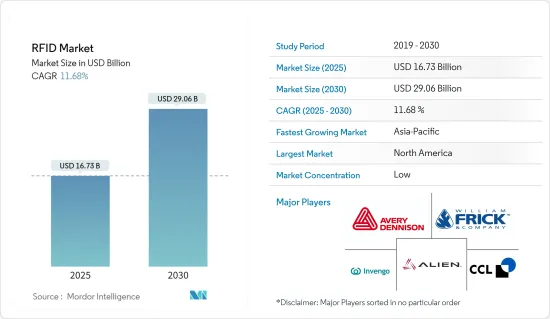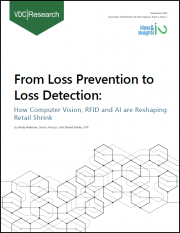
|
시장보고서
상품코드
1690907
세계의 RFID 시장 : 점유율 분석, 산업 동향 및 통계, 성장 예측(2025-2030년)RFID - Market Share Analysis, Industry Trends & Statistics, Growth Forecasts (2025 - 2030) |
||||||
세계의 RFID 시장 규모는 2025년 167억 3,000만 달러로 추정되며, 예측 기간 중(2025-2030년) CAGR 11.68%를 나타낼 전망이며, 2030년에는 290억 6,000만 달러에 이를 것으로 예측됩니다.

공급망 관리 및 물류에서는 RFID 기술이 널리 사용됩니다. 센서 기반 RFID 기술은 제품 원산지를 추적하고 추적하고 공급망 내에서 오염 및 변조의 원인을 방지하기 위해 제품 포장에 통합되어 있습니다.
주요 하이라이트
- 물류 및 운송은 RFID 기술의 주요 도입 분야입니다. 창고 관리, 야드 관리, 배송/운송, 배송 센터 등은 일반적으로 RFID 추적 기술이 사용되는 분야의 일부입니다.
- RFID(Radiofrequency Identification)는 주로 태그와 리더라는 두 가지 주요 구성 요소로 구성된 무선 시스템을 말합니다. 리더는 기본적으로 하나 이상의 안테나로 구성된 장치로 전파를 방출하고 RFID 태그에서 신호를 수신합니다. 태그는 전파를 이용하여 ID나 기타 중요한 정보를 근처의 리더에게 전달하는 것으로, 패시브 유형과 액티브 유형이 있습니다.
- 패시브 RFID 태그는 주로 리더로부터 전원이 공급되며 배터리가 없습니다. 그러나 액티브 유형 RFID 태그는 배터리로부터 전력을 공급받습니다. 이 RFID 태그는 하나의 일련 번호에서 몇 페이지의 중요한 데이터에 이르기까지 광범위한 정보를 저장할 수 있습니다. RFID 리더는 손으로 운반할 수 있는 모바일 폼 팩터로 제공되며 기둥이나 머리 위에 장착할 수 있습니다.
- RFID 기술의 가장 일반적인 용도 중 하나는 공급망에서 상품 추적, 생산 생산 라인으로 이동하는 부품 추적, 자산 추적, 보안, 고객이 현금을 사용하지 않고 상품 대금을 지불하는 결제 시스템 등입니다. 또한 RFID는 건강 관리 산업에서 환자의 손목 밴드에 자주 사용되며 시설의 액세스 제어 및 보안을위한 변조 방지 된 정확한 식별을 제공합니다.
- 또한 세계 여러 물류 센터와 창고가 개선 프로그램의 일환으로 전체 프로세스의 효율성을 높이기 위해 투자를 하고 있습니다. 시장 상황에서 이러한 투자는 RFID 기술의 성장과 도입을 촉진할 것으로 예상됩니다.
- COVID-19 팬데믹은 소매업체의 과제를 증가시켰습니다. 팬데믹은 또한 소매업체가 RFID를 보다 대규모로 도입하도록 지원했습니다. 팬데믹은 이미 진행 중이었던 디지털 변환의 흐름을 가속화했습니다.
RFID 시장 동향
소매 부문이 큰 시장 점유율을 차지할 전망
- 소매업의 RFID는 RFID 리더에게 신호를 보내는 RFID 태그를 상품에 사용하는 것으로, RFID 태그는 소프트웨어에 의해 처리되어 거래, 재고 관리, 재고 레벨, 개별 고객의 구매 주문 이력 등의 결과를 실시간으로 제공합니다. 소매업의 RFID는 수작업으로 시간이 오래 걸리고 정해진 간격으로만 실행되는 전형적인 소매업의 재고 과정을 완화합니다. 상품 추적은 소매업체가 RFID를 사용하는 주요 용도 중 하나입니다. 소매업에서 RFID는 도난을 방지하고 일반적으로 이동하고 종종 잊어버린 상품을 추적하는 데에도 사용할 수 있습니다.
- 일부 기업은 인벤토리를 관리하는 방법으로 RFID를 채택하고 있습니다. Zara, H&M, Target, Macy's, Uniqlo, Nike, Adidas, Lululemon, Footlocker, Levi's, Tommy Hilfiger, Ralph Lauren, Victoria's Secret 등이 대표적입니다. 전자상거래는 상점에서의 완성 및 BOPIS(온라인 구매 및 상점에서 수령)와 같은 프로세스를 지원하기 위해 높은 재고 정밀도가 요구되기 때문에 도입의 대부분에 박차를 가하고 있습니다.
- RFID 처리된 상품은 또한 경영진이 사실 데이터를 이용할 수 있게 됩니다. 재고 정밀도는 수축을 줄이고 이익을 향상시키는 데 매우 중요하기 때문에 RFID는 보다 스마트한 구매 결정으로 이어지고 경영진은 더 나은 비용 관리를 할 수 있습니다.
- RFID를 사용하면 전반적인 상품 관리가 개선될 수 있습니다. 또한 판매 완료를 쉽게 확인할 수 있으므로 최상위 라인의 수익도 증가합니다. 요컨대, RFID를 도입하면 상품이 어디에 보관되든 보다 정확한 계산이 가능해지므로 보다 수익성 높은 실적이 보장됩니다.
- 세계 소매업체는 특히 의류 비즈니스에서 RFID 기술을 광범위하게 활용합니다. 캐나다에 본사를 둔 Logistik Unicorp는 캐나다 군사 군복이 엄격한 품질 요구 사항을 충족하는 보증과 함께 신속하게 배송되도록 보장하는 도구로 무선 주파수 식별을 사용했습니다. 이를 통해 상품 배송에 필요한 시간을 35% 단축할 수 있었습니다. 이러한 노력은 시장에서 RFID의 새로운 기회와 개척, 노력을 촉진하고 소매 상품에 대한 의존도를 낮춥니다.
- 모든 판매 채널에서 고객의 요구를 충족시키는 옴니 채널 소매 전략은 생존을 위한 우선순위가 되었습니다. RFID는 변화하는 소비자 수요에 대응하기 위해 소매업체의 상점, 기업, 배송 센터에 걸친 상품의 가시성을 확대했습니다.
아시아태평양이 급성장 시장이 될 전망
- 아시아태평양은 시장에서 큰 점유율을 차지하며 예측 기간 동안 큰 성장이 예상됩니다. 오토메이션 분야의 도입과 연구가 급속히 진행되고 있으며, Industry 4.0이 대폭 확대되고 있는 것이 이 지역에서 RFID 솔루션 수요를 촉진하고 있습니다.
- 이 지역의 성장은 생산성을 높이기 위해 제조 장비에 RFID 시스템의 도입이 증가하는 것이 큰 요인이 되었습니다. 전자 ID 카드나 스마트 카드에 탑재되는 RFID 태그의 수용 확대도, 이 지역의 RFID 시장 성장 촉진요인이 되고 있습니다.
- 소매 부문의 확대와 함께 고객의 쇼핑 경험을 향상시키고 창고 관리 프로세스를 최적화하기 위해 소매업체가 디지털 기술 도입에 힘을 쏟고 있다는 점도 RFID 시장 성장에 기여하는 중요한 요소 중 하나입니다. RFID는 생산 환경에서 제품과 재료를 다루는 데 사용되는 효율적인 기술 중 하나입니다.
- 이 지역에서의 제조업의 정세는 확대되고 있으며, 자동화나 사물인터넷(IIoT) 솔루션의 도입이 진행되고 있는 것도 함께 시장의 성장을 뒷받침하고 있습니다. 또한 다양한 업종의 조직에 의한 자산관리에 대한 투자 증가와 스마트시티 등 정부의 이니셔티브와 더불어 비접촉 인프라에 대한 요구가 높아지고 있는 것도 예측기간 중 시장 성장을 더욱 뒷받침하고 있습니다.
- 또한 대중교통은 예측 기간 동안 시장이 확대될 것으로 예상되는 분야 중 하나입니다. 그러나 일부 억제요인은 시장 성장을 제한하고 있습니다. RFID 시스템의 도입과 관련된 높은 비용이 시장 성장에 어려움을 줄 수 있습니다. 또한 장치의 상호 운용성 문제는 예측 기간 동안 시장 성장을 방해할 수 있습니다.
- 인도와 같은 국가에서는 산업이 성숙함에 따라 RFID 기술의 채택이 급증할 것으로 예상되며, COVID-19의 유행으로 인해 비접촉 솔루션의 요구가 커지고 있습니다.
RFID 산업 개요
RFID 시장은 복잡하고 경쟁이 치열하며 Avery Dennison Corporation, Alien Technology Corporation, CCL Industries Inc., William Frick & Company 등의 대기업으로 구성되어 있습니다. 대기업은 해외에서 고객 기반의 확대에 주력하고 있습니다. 각 회사는 시장 점유율을 확대하고 수익성을 높이기 위해 전략적 공동 이니셔티브를 활용합니다. 경쟁, 급속한 기술 발전, 소비자 선호의 빈번한 변화가 예측 기간 동안 각 회사 시장 성장 위협이 될 것으로 예상됩니다.
- 2023년 5월 - CCL Industries INC.는 eAgile Inc.와 Alert Systems의 지적 재산을 인수했다고 발표했습니다. 5,400만 달러의 인수 금액에는 700만 달러를 5년간 연기하여 100만 달러의 순현금을 상정하고 있습니다. 새로운 사업은 CCL 라벨의 헬스케어 및 스페셜리티 사업의 필수적인 부분이 되어 RFID의 노하우가 전사에 합류합니다.
- 2023년 2월 - Avery Dennison Smartrac은 RFID 태그의 새로운 제조 능력에 1억 달러를 투자했습니다. 이 투자는 모든 아이템에 고유한 디지털 ID를 부여하고 수동 UHF RFID 태그 수요 증가에 대응하고 주문에 신속하게 대응할 수 있도록 하는 AIPIA 회원의 야망을 지원합니다.
기타 혜택:
- 엑셀 형식 시장 예측(ME) 시트
- 3개월간의 애널리스트 서포트
목차
제1장 서론
- 조사의 전제조건과 시장 정의
- 조사 범위
제2장 조사 방법
제3장 주요 요약
제4장 시장 인사이트
- 시장 개요
- 업계 이해관계자 분석
- RFID 태그의 유형
- 업계의 매력도 - Porter's Five Forces 분석
- 공급기업의 협상력
- 구매자의 협상력
- 신규 참가업체의 위협
- 대체품의 위협
- 경쟁 기업간 경쟁 관계
- RFID의 규제와 표준
- RFID와 IoT
- RFID와 관련 시장에 대한 COVID-19의 영향
- RFID 도입의 중요한 성공 요인
- 갭 분석
제5장 시장 역학
- 시장 성장 촉진요인
- 디지털 개발을 지지하는 정부의 정책
- 생산성 향상과 보안 및 액세스 제어 용도를 목적으로 한 제조 장치에 RFID 도입 증가
- 시장의 과제
제6장 시장 세분화
- 기술별
- RFID 태그
- RFID 인텔로게이터
- RFID 소프트웨어 및 서비스
- 액티브 RFID 및 RTLS
- 용도별
- 소매
- 헬스케어 및 의료
- 여객 수송 및 자동차
- 제조업
- 소비자 제품
- 기타 용도
- 지역별
- 북미
- 유럽
- 아시아태평양
- 라틴아메리카
- 중동 및 아프리카
제7장 경쟁 구도
- 기업 프로파일
- Avery Dennison Corporation
- Alien Technology Corporation
- William Frick & Company
- Invengo Technology Pte Ltd.
- Impinj Inc.
- CCL Industries Inc.
- Nedap NV
- Zebra Technologies Corporation
- Trace-Tech ID Solutions SL
- Hangzhou Century Co. Ltd.
- SML Group Limited
- Honeywell Productivity and Workflow Solutions
- CHILITAG Technology Ltd
- Ceyon Technology Co. Ltd.
- JADAK Technologies Inc.
제8장 투자 분석
제9장 시장의 미래
JHS 25.04.09The RFID Market size is estimated at USD 16.73 billion in 2025, and is expected to reach USD 29.06 billion by 2030, at a CAGR of 11.68% during the forecast period (2025-2030).

Supply chain management and logistics make widespread usage of RFID technology. Sensor-based RFID technology is being increasingly integrated into product packaging to track and trace the origin of the product and prevent any source of contamination or tampering within the supply chain.
Key Highlights
- Logistics and transportation are major areas of implementation for RFID technology. Warehouse management, yard management, shipping and freight, and distribution centers are some of the areas where RFID tracking technology is usually used.
- Radiofrequency identification (RFID) primarily refers to a wireless system comprising two major components: tags and readers. The reader is basically a device comprising one or more antennas that emits radio waves and receive signals back from the RFID tags. The tags, which make use of radio waves to communicate their identity and other crucial information to the nearby readers, can be passive or active type.
- The passive RFID tags are mainly powered by the readers and do not have a battery. However, the active type RFID tags are powered by batteries. These RFID tags can store a wide range of information, right from one serial number to several pages of crucial data. The RFID readers are offered in a mobile form factor so that they can be carried by hand or can either be mounted on a post or overhead.
- One of the most common usages of RFID technology has been tracking goods in the supply chain, tracking parts moving to a manufacturing production line, tracing assets, security, and payment systems that let clientele pay for items without using cash. In addition, RFID is frequently used in the healthcare industry on patient wristbands to offer tamper-proof, exact identification for facility access control and security.
- Moreover, multiple distribution centers and warehouses around the globe have been investing in improving their process efficiency to increase the efficiency of the overall processes as a part of their improvement programs. Such investments in the market landscape are anticipated to drive the growth and implementation of RFID technology.
- The COVID-19 pandemic has increased challenges for retailers. The pandemic also pushed retailers to adopt RFID on a much larger scale. The pandemic became an accelerator of the digital transformation trend, which was already underway.
RFID Market Trends
Retail Segment is Expected to Hold a Major Market Share
- RFID in retail involves the utilization of RFID tags on items that emit signals to RFID readers, which are then processed by the software, providing real-time results for transactions, stock taking, inventory levels, or individual customer purchase order history. RFID in retail eases the typical retail inventory process, which is manual, time-consuming, and only performed at predetermined intervals. Item tracking is one of the major applications that retailers use RFID. RFID in retail can also be used to prevent theft and track items that are usually moved and often misplaced.
- Several companies have adopted RFID as an approach to control inventories. Leaders include Zara, H&M, Target, Macy's, Uniqlo, Nike, Adidas, Lululemon, Footlocker, Levi's, Tommy Hilfiger, Ralph Lauren, and Victoria's Secret. E-commerce is fueling much of the adoption, with high inventory accuracy levels required to support processes like store fulfillment and BOPIS (buy online, pick up in-store).
- RFID-processed merchandise also makes factual data available to management. It may lead to smarter purchase decisions and give management better expense control, as inventory accuracy is crucial to lowering shrinkage, thus, better profits.
- Usage of RFID may improve overall merchandise management; accurate tracking of inventory and its location saves money. It also drives greater topline revenues, as it becomes easier to assure that sales are completed. Bottom line, adoption of the system ensures more profitable performance, as there is a more accurate accounting of the merchandise wherever it is stored.
- Retailers across the world have been making extensive use of RFID technology, especially in the Apparel business. The Canada-based company, Logistik Unicorp, has been using radio frequency identification as a tool to ensure that Canadian military uniforms are delivered swiftly, along with the guarantee of meeting strict quality requirements. It has been able to reduce the time required to ship goods by 35%. Such initiatives encourage new opportunities and developments and initiatives for RFID in the market and decrease the dependency on retail goods.
- Omnichannel retail strategies to meet the customers' needs on all sales channels became a priority for survival. RFID extended retailers' visibility of merchandise across the stores and the enterprise and distribution centers to meet ever-changing consumer demands.
Asia Pacific is Expected to be the Fastest Growing Market
- The Asia Pacific region is anticipated to hold a significant share of the market and is expected to witness significant growth over the forecast period. The rapidly increasing implementation and research work in the field of automation and a significant expansion of industry 4.0 have been driving the demand for RFID solutions in the region.
- The region's growth has been significantly driven by the increasing installation of these RFID systems in manufacturing units in order to improve productivity. The growing acceptance of electronic identity cards and RFID tags that are located in smart cards is also acting as a driver for the growth of the RFID market in the region.
- The expanding retail sector, along with the rising retailers' focus on embracing digital technologies in order to enhance the customer's shopping experience and optimize the warehouse management process, has also been one of the key factors contributing to the growth of the RFID market. RFID has been one of the efficient technologies used to handle goods and materials in the production environment.
- The expanding manufacturing landscape in the region, coupled with the increasing adoption of automation and Industrial Internet of Things (IIoT) solutions in the sector, has been propelling the market's growth. Also, the growing investments in asset management by organizations across various verticals and the rising need for contactless infrastructure coupled with government initiatives such as smart cities will further drive the growth of the market during the forecast period.
- Moreover, the public transportation sector is anticipated to be one of the areas in which the market is expected to expand over the forecast period. However, some restraints are limiting the growth of the market. The higher cost associated with installing RFID systems may challenge the market's growth. The device interoperability issues can also hinder the growth of the market over the forecasted period.
- Countries such as India are expected to witness a surge in the adoption of RFID technology as industries mature, and the COVID-19 pandemic is increasing the need for contactless solutions.
RFID Industry Overview
The RFID Market is fragemented and highly competitive and consists of several major players like Avery Dennison Corporation, Alien Technology Corporation, CCL Industries Inc., William Frick & Company, etc. The major players are focusing on expanding their customer base across foreign countries. The companies are leveraging strategic collaborative initiatives to increase their market share and increase their profitability. The competition, rapid technological advancements, and frequent changes in consumer preferences are expected to pose a threat to the market's growth of the companies during the forecast period.
- May 2023 - CCL Industries INC, announced it has acquired eAgile Inc. and the intellectual property of Alert Systems with the USD 54 million purchase price includes an estimated USD 1 million net cash assumed with USD 7 million deferred for five years. The new business will become an integral part of CCL Label's Healthcare & Specialty business while adding RFID know-how across the company.
- Februray 2023 - Avery Dennison Smartrac invests USD 100milion in new RFID tag making capacity, The investment supports the AIPIA member's ambition of giving every item a unique digital identity and meeting the growing demand for passive UHF RFID tags as well as increasing how quickly it can fulfil orders.
Additional Benefits:
- The market estimate (ME) sheet in Excel format
- 3 months of analyst support
TABLE OF CONTENTS
1 INTRODUCTION
- 1.1 Study Assumptions and Market Definition
- 1.2 Scope of the Study
2 RESEARCH METHODOLOGY
3 EXECUTIVE SUMMARY
4 MARKET INSIGHT
- 4.1 Market Overview
- 4.2 Industry Stakeholder Analysis
- 4.3 RFID Tag Types
- 4.4 Industry Attractiveness - Porter's Five Forces Analysis
- 4.4.1 Bargaining Power of Suppliers
- 4.4.2 Bargaining Power of Buyers
- 4.4.3 Threat of New Entrants
- 4.4.4 Threat of Substitutes
- 4.4.5 Intensity of Competitive Rivalry
- 4.5 RFID Regulations and Standards
- 4.6 RFID and IoT
- 4.7 Impact of COVID-19 on RFID and Allied Markets
- 4.8 Critical Success Factors for RFID Implementation
- 4.9 Gap Analysis
5 MARKET DYNAMICS
- 5.1 Market Drivers
- 5.1.1 Government Policies Favoring Digital Development
- 5.1.2 Increasing Installation of RFID in Manufacturing Units for Productivity Improvement and Security and Access Control Applications
- 5.2 Market Challenges
6 MARKET SEGMENTATION
- 6.1 By Technology
- 6.1.1 RFID Tags
- 6.1.2 RFID Interrogators
- 6.1.3 RFID Software/Services
- 6.1.4 Active RFID/RTLS
- 6.2 By Application
- 6.2.1 Retail
- 6.2.2 Healthcare and Medical
- 6.2.3 Passenger Transport/Automotive
- 6.2.4 Manufacturing
- 6.2.5 Consumer Products
- 6.2.6 Other Applications
- 6.3 By Geography
- 6.3.1 North America
- 6.3.2 Europe
- 6.3.3 Asia Pacific
- 6.3.4 Latin America
- 6.3.5 Middle East and Africa
7 COMPETITIVE LANDSCAPE
- 7.1 Company Profiles
- 7.1.1 Avery Dennison Corporation
- 7.1.2 Alien Technology Corporation
- 7.1.3 William Frick & Company
- 7.1.4 Invengo Technology Pte Ltd.
- 7.1.5 Impinj Inc.
- 7.1.6 CCL Industries Inc.
- 7.1.7 Nedap NV
- 7.1.8 Zebra Technologies Corporation
- 7.1.9 Trace-Tech ID Solutions SL
- 7.1.10 Hangzhou Century Co. Ltd.
- 7.1.11 SML Group Limited
- 7.1.12 Honeywell Productivity and Workflow Solutions
- 7.1.13 CHILITAG Technology Ltd
- 7.1.14 Ceyon Technology Co. Ltd.
- 7.1.15 JADAK Technologies Inc.



















